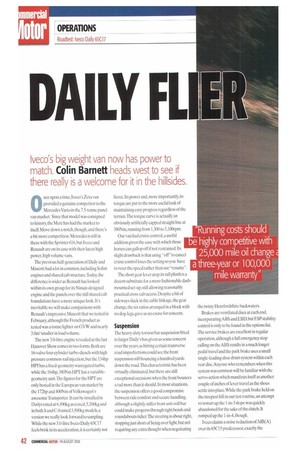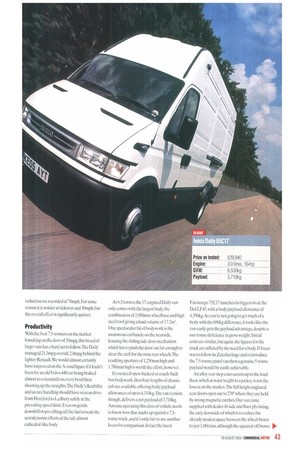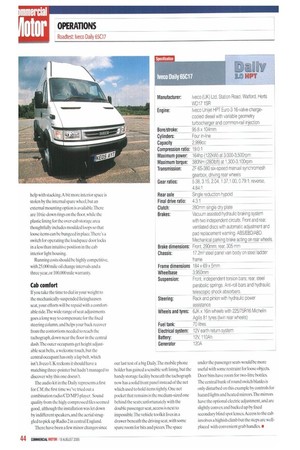DA Lif FL
Page 42

Page 43

Page 44

If you've noticed an error in this article please click here to report it so we can fix it.
Iveco's big weight van now has power to
match. Colin Barnett heads west to see if
there really is a welcome for it in the hillsides.
0 nce upon a time, Iveco's Zeta van provided a genuine competitor to the Mercedes Vario in the 7.5-tonne panel van market. Since that model was consigned to history, the Mere has had the market to itself. Move down a notch, though, and there's a bit more competition. Mercedes is still in there with the Sprinter 616, but Iveco and Renault are on its case with their latest high power, high volume vans.
The previous half-generation of Daily and Mascott had a lot in common, including Sofim engines and shared cab structure.Today, the difference is wider as Renault has looked within its own group for its Nissan-designed engine and the panels over the still shared cab foundations have a more unique look. It's inevitable we will make comparisons with Renault's impressive Mascott that we tested in February, although the French product as tested was a tonne lighter on GVW and nearly 3.0m3 smaller in load volume.
The new 3.0-litre engine revealed at the last Hanover Show comes in two forms. Both are 16-valve four-cylinder turbo-diesels with high pressure common-rail injection, but the 134hp HP! has a fixed-geometry wastegated turbo, while the 164hp,380Nm HFT has a variablegeometry unit.The figures for the HPT are only bested in the European van market by the 172hp and 400Nm of Volkswagen's awesome Transporter. It can be installed in Dailys rated at 6,500kg as tested.5,200kg and in both S and C-framed 3,500kg models, a version we really look forward to sampling. While the new 3.0-litre lveco Daily 65C17 feels brisk in its acceleration, it is certainly not fierce. Its power and, more importantly, its torque are put to the more useful task of maintaining easy progress regardless of the terrain.The torque curve is actually an obviously artificially capped straight line at 380Nm, running from 1,300 to 3,100rpm.
Our van had cruise control, a useful addition given the ease with which those horses can gallop off if not restrained. Its slight drawback is that using "off' to cancel cruise control loses the setting so you have to reset the speed rather than use "resume".
The short gear lever atop its tall plinth is a decent substitute for a more fashionable dashmounted set-up,still allowing reasonably practical cross-cab access. Despite a bit of sideways slack in the cable linkage, the gear change, the six ratios arranged in a block with no dog-legs, gave us no cause for concern.
Suspension
The heavy-duty torsion bar suspension fitted to larger Daily's has given us some concern over the years. as hitting certain transverse road imperfections could see the front suspension still bouncing a hundred yards down the road.This characteristic has been virtually eliminated, but there are still exceptional occasions when the front bounces a tad more than it should. In most situations, the suspension offers a good compromise between ride comfort and secure handling, although a slightly stiffer front anti-roll bar could make progress through tight bends and roundabouts tidier.The steering is about right, stopping just short of being over light, but not requiring any extra thought when negotiating the twisty Herefordshire backwaters.
Brakes are ventilated discs at each end, incorporating ABS and EBD, but ESP stability control is only to be found in the options list. The service brakes are excellent in regular operation, although a full emergency stop calling on the ABS results in a much longer pedal travel and the park brake uses a small single-leading shoe drum system within each rear disc. Anyone who remembers when this system was common will be familiar with the servo-action which manifests itself as another couple of inches of lever travel as the shoes settle into place. While the park brake held on the steepest hill in our test routine, an attempt to restart up the 1-in-3 slope was quickly abandoned for the sake of the clutch. It romped up the 1-in-4, though.
Iveco claims a noise reduction of 3dB (A) over its 65C15 predecessor, exactly the reduction we recorded at 70mph. For son-le reason it is noisier at tickover and 30mph, but the overall effect is significantly quieter.
Productivity
With the best 7.5-tonners on the market knocking on the door of 20mpg, this breed of large vans has a hard act to follow.The Daily managed 21.3mpg overall. 2.0mpg behind the lighter Rena ult.We would almost certainly have improved on the A-road figure if it hadn't been for an old Volvo 440 car being braked almost to a standstill on every bend then shooting up the straights.The Daily's flexibility and secure handling should have seen us drive from Hereford to Ledbury safely at the prevailing speed limit. Even on gentle downhill slopes, lifting off the fuel reveals the aerodynamic effects of the tall, almost cathedral-like body. A16.5 tonnes, the I 7-engined Daily van only comes with the largest body, the combination of 3,950mm wheelbase and high steel roof giving a load volume of 17.2m3. One spectacular bit of bodywork is the monstrous carbuncle on the nearside, housing the sliding side door mechanism which has to push the door out far enough to clear the arch for the twin rear wheels. The resulting aperture of 1,250mm high and 1,780mm high is worth the effort, however.
If you need open-backed or coach-built box bodywork,then four lengths of chassiscab are available.offering body/payload allowances of up to 4.310kg.The van version, though. delivers a net payload of 3,710kg. Anyone operating this class of vehicle needs to know how that stacks up against a 7.5tonne truck, and it's only fair to use another I veco for comparison. In fact the latest Euroc.argo 75E17 matches its biggest rival,the Daf LF45, with a body/payload allowance of 4.390kg. As you're not going to get much of a body with the 680kg difference, it looks like the van easily gets the payload advantage, despite a one tonne deficiency in gross weight. Initial costs are similar, but again, the figures for the truck are inflated by the need for a body. If Iveco was to follow its Zeta heritage and reintroduce the 7.5-tonne panel van then a genuine 5-tonne payload would be easily achievable.
An alloy rear step eases access up to the load floor, which at waist height to a jockey is not the lowest on the market.The full height unglazed rear doors open out to 270' where they are held by strong magnetic catches. Our van came supplied with dealer-fit side and floor ply-lining. the only downside of which is to reduce the already modest space between the wheel-boxes to just 1,001mm, although the squared-off boxes help with stacking. A bit more interior space is stolen by the internal spare wheel, but an external mounting option is available.There are 10 tie-down rings on the floor, while the plastic lining for the over-cab storage area thoughtfully includes moulded loops so that loose items can be bungeed in place.There's a switch for operating the loadspace door locks in a less than intuitive position in the cab interior light housing.
Running costs should be highly competitive, with 25,000 mile oil change intervals and a three year, or 100,000 mile warranty.
Cab comfort
If you take the time to dial in your weight to the mechanically-suspended Isringhausen seat, your efforts will be repaid with a comfortable ride. The wide range of seat adjustments goes a long way to compensate for the fixed steering column, and helps your back recover from the contortions needed to reach the tachograph, down near the floor in the central dash.The outer occupants get height adjustable seat belts, a welcome touch, but the central occupant has only a lap belt, which isn't. Iveco UK reckons it should have a matching three-pointer but hadn't managed to discover why this one doesn't.
The audio kit in the Daily represents a first for CM, the first time we've tried out a combination radio/CD/MP3 player. Sound quality from the higly compressed files seemed good, although the installation was let down by indifferent speakers, and the aerial struggled to pick up Radio 2 in central England.
There have been a few minor changes since our last test of a big Daily. The mobile phone holder has gained a sensible soft lining, but the handy storage facility beneath the tachograph now has a solid front panel instead of the net which used to hold items tightly. One net pocket that remains is the medium-sized one behind the seats; unfortunately with the double passenger seat, access is next to impossible.The vehicle toolkit lives in a drawer beneath the driving seat, with some spare room for bits and pieces.The space under the passenger seats would be more useful with some restraint for loose objects. Door bins have room for two-litre bottles. The central bank of round switch blanks is only disturbed on this example by controls for hazard lights and heated mirrors.The mirrors have the optional electric adjustment, and are slightly convex and backed up by fixed secondary blind spot lenses, Access to the cab involves a highish climb but the steps are wellplaced with convenient grab handles, •
















































































































































































































